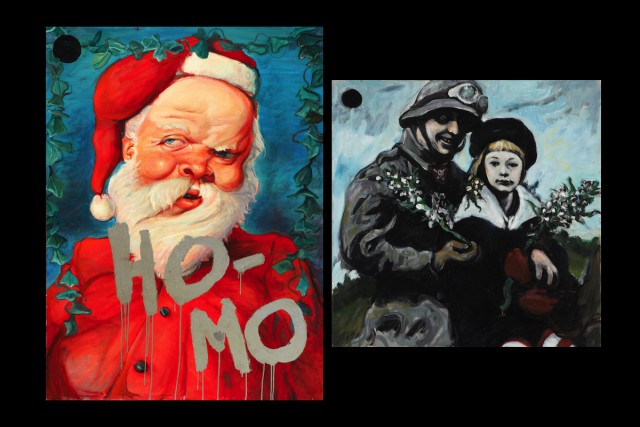Art & Exhibitions
Chuck Connelly Makes His Mark
THE DAILY PIC: At the Warhol Museum, a neo-expressionist casts doubt on expression.

THE DAILY PIC: At the Warhol Museum, a neo-expressionist casts doubt on expression.

Blake Gopnik


Two pictures by the Philadelphia painter Chuck Connelly: Homo, from 1979, on the left, and the much smaller Soldier and Girl, from 2009. Both are on view in the mini-survey of his career now at the Andy Warhol Museum in Pittsburgh. Connelly won a following as a neo-expressionist in 1980s New York, but what interests me about these two pictures is in fact their resistance to the naïve and tired idea of “expression.”
That starts with Homo and its use of text with a political tinge–more often a trademark of anti-expressive conceptualism and its attack on “pure” painting. (Although here text also has links to graffiti, and leaves us wondering if the writing is an insult thrown at a leering Santa impersonator–“Come sit on my lap, little boy”–or a joyous “Ho! Ho! Homo!” to liberated sex.)
The resistance to “expression” gets stronger when you know that the pictures are credited to a fictional artist named Fred Scaboda, who has been doubling for Connelly for four decades now. What does it mean for a painting to display the “self-expression” of a maker who does not, in fact, exist?
And the resistance takes over completely in that painted black dot in the corner of both pictures. Whereas most of a Connelly surface is about paint gone wild, that dot is a black hole where paint goes to die. If expressive paint is all about irregularity, then the dot, with its infinite dimensions of symmetry, is its antithesis: It is just about as unexpressive, as minimal, as intensely and iconically geometrical as anything can be. (Echoing Giotto’s famous move, Connelly draws his circles freehand.)
More importantly, in Connelly’s output that unexpressive dot has always stood in for the most expressive gesture of all: The artist’s unique signature. The dot descends from the identifying “chop” of a Japanese printmaker, as appropriated by radical Western aesthetes like Whistler. But of course Connelly has utterly deaestheticized it, turning Whistler’s marker of personality into something utterly impersonal. The force of that impersonality, Connelly said, lets him go up against the Big Signers like Picasso.
He also thinks of his dot as a sort of corporate trademark that, in its very neutrality, would allow it to be stamped on any saleable good–“like the Good Housekeeping Seal but with dark implications,” Connelly said. He has imagined the existence of a dot-wielding megacorporation whose black hole of a logo could be attached to all the little companies and products it has swallowed up. His spot becomes the Jolly Roger of mergers and acquisitions.
I hate signatures on the front of pictures: They usually come closer to defacement than enhancement, and, when they aren’t about pure egomania, are really just the flip-side of the price tag. (Barnett Newman ruined many masterpieces by signing them.) Connelly’s black dot absorbs all that history, and spits it back at us.
For a full survey of past Daily Pics visit blakegopnik.com/archive.